 |
Making Changes to Printer Settings
 Making the print quality settings Making the print quality settings
 Duplex printing Duplex printing
 Displaying information about consumables with the printer driver Displaying information about consumables with the printer driver
 Ordering Consumables Ordering Consumables
 Resizing printouts Resizing printouts
 Modifying the print layout Modifying the print layout
 Using a watermark Using a watermark
 Using headers and footers Using headers and footers
 Using an overlay Using an overlay
 Using storage form overlay Using storage form overlay
 Making Extended Settings Making Extended Settings
 Making Optional Settings Making Optional Settings
 Printing a status sheet Printing a status sheet
Making the print quality settings
You can change the print quality of printouts through settings in the printer driver. With the printer driver, you can make the print settings by choosing from a list of predefined settings, or customizing the settings.
Choosing the print quality by using the Automatic setting
You can change the print quality of printouts to favor speed or detail. There are five quality modes for the color printing mode and three for the black-and-white printing mode.
When Automatic is selected on the Basic Settings tab, the printer driver takes care of all detailed settings according to the color setting you select. Print quality and color are the only settings you have to make. You can change other settings such as paper size or orientation in most applications.
 |
Note: |
 |
|
The printer driver’s online help provides details on printer driver settings.
|
|
 |
Click the Basic Settings tab.
|
 |
Click Automatic, then choose desired printing quality.
|
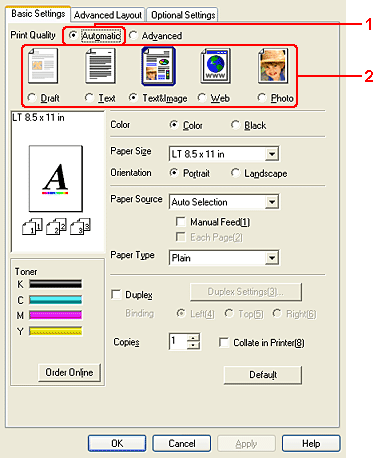
 |
Click OK to apply the settings.
|
The printer driver provides the following quality modes.
Color
Draft, Text, Text&Image, Web, Photo
Monochrome
Draft, Text&Image, Photo
 |
Note: |
 |
|
If printing is unsuccessful or a memory-related error message appears, selecting a different print quality may allow printing to proceed.
|
|
Using the predefined settings
The predefined settings are provided to help you optimize print settings for a particular kind of printout, such as presentation documents or images taken by a video or digital camera.
Follow the steps below to use the predefined settings.
 |
Click the Basic Settings tab.
|
 |
Select Advanced. You will find the predefined settings in the list below of Automatic.
|

 |  |
Note: |
 |  |
|
This screen may vary depending on your operating system version.
|
|
 |
Select the most appropriate setting from the list according to the type of document or image you want to print.
|
When you choose a predefined setting, other settings such as Printing Mode, Resolution, Screen, and Color Management are set automatically. Changes are shown in the current settings list on the Setting Information dialog box that appears by pressing the Setting Info. button on the Optional Settings tab.
 |
Note: |
 |
|
The printer driver’s online help provides details on printer driver settings.
|
|
Customizing print settings
If you need to change detailed settings, make the settings manually.
Follow the steps below to customize your print settings.
 |
Click the Basic Settings tab.
|
 |
Click Advanced, then click More Settings.
|
 |
Choose Color or Black as the Color setting, then choose desired printing resolution with the Resolution slider bar.
|

 |  |
Note: |
 |  |
-
The Web Smoothing check box is not available when PhotoEnhance is selected. Note this setting is effective for screens that include full color, 24, or 32 bit images. It is not effective for screens that include only illustrations, graphs, and text, and do not include any images.
|
|
 |
Click OK to apply the settings and return to the Basic Settings tab.
|
To save your custom settings, click Advanced, then click Save Settings on the Basic Settings tab. The Custom Settings dialog box appears.

Type a name for your custom settings in the Name box, then click Save. Your settings will appear in the list below of Automatic on the Basic Settings tab.
 |
Note: |
 |
-
To delete a custom setting, click Advanced, click Save Settings on the Basic Settings tab, select the setting in the Custom Settings dialog box, then click Delete.
|
|
If you change any setting in the More Settings dialog box when one of your custom settings is selected in the Advanced Settings list on the Basic Settings tab, the setting selected in the list changes to Custom Settings. The custom setting that was previously selected is not affected by this change. To return to your custom setting, simply reselect it from the current settings list.
Duplex printing prints on both sides of the paper. When printing for binding, the binding edge can be specified as required to produce the desired page order.
Printing with the Duplex Unit (models with Duplex Unit only)
Follow the steps below to print with the Duplex Unit.
 |
Click the Basic Settings tab.
|
 |
Select the Duplex check box, then select Left, Top, or Right as the Binding position.
|
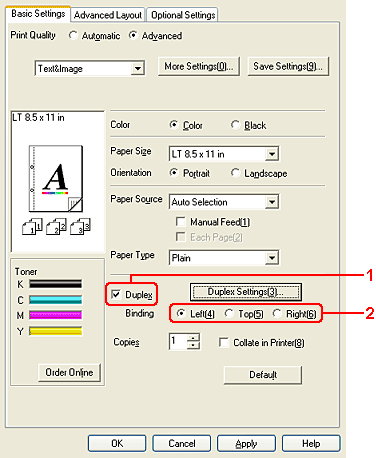
 |  |
Note: |
 |  |
|
The Duplex check box appears only when the Duplex Unit is recognized by the printer driver. If you selected Update the Printer Option Automatically on the Optional Settings tab, confirm that Duplex Print Unit is set to Installed. If you selected Update the Printer Option Manually on the Optional Settings tab, click the Settings button and select the Duplex Print Unit check box.
|
|
 |
Click Duplex Settings to open the Duplex Settings dialog box.
|
 |
Specify the Binding Margin for the front and back sides of the paper, then select whether the front or back side of the paper is to be printed as the Start Page.
|

 |
When printing for binding as a booklet, select the Binding Method check box and make appropriate settings. For details about each setting, see online help.
|
 |
Click OK to apply the settings and return to the Basic Settings tab.
|
Doing duplex printing manually (models without Duplex Unit only)
 |
Click the Basic Settings tab.
|
 |
Make sure that the Manual Feed check box is off.
|
 |  |
Note: |
 |
Select the Duplex (Manual) check box, then select Left, Top, or Right as the binding position.
|

 |
Click Duplex Settings to open the Duplex Settings dialog box.
|
 |
Specify the Binding Margin for the front and back sides of the paper, then select whether the front or back side of the paper is to be printed as the Start Page.
|
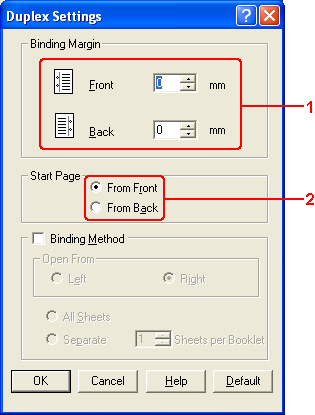
 |
When printing for binding as a booklet, select the Binding Method check box and make appropriate settings. For details about each setting, see online help.
|
 |
Click OK.
|
 |
Execute the print job.
|
 |  |
Note: |
 |  |
|
The alert screen appears on the computer. Click the OK button on the screen.
|
|
 |
After printing on one side, reload the paper into the MP tray with the printed surface face-up as shown below. Then, press the  Start/Stop button. Start/Stop button.
|
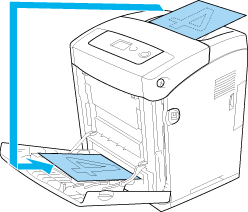
 |
Note: |
Displaying information about consumables with the printer driver
The remaining service lives of the imaging cartridges are displayed on the Basic Settings tab when EPSON Status Monitor is installed. The Order Online button is also available. You can set the interval at which the information about the consumables is updated on the Consumables Info Settings dialog box that appears by clicking the Consumables Info Settings button on the Optional Settings tab.
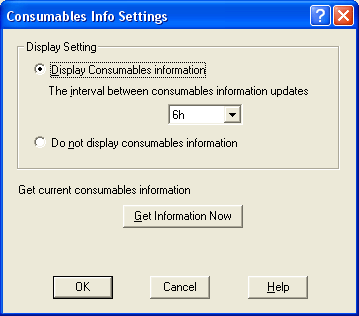
 |
Note: |
 |
-
The driver and EPSON Status Monitor use different methods to measure the remaining service lives of the imaging cartridges. Because of this, the information that is displayed in EPSON Status Monitor and the Basic Settings tab might be different. Use EPSON Status Monitor to get more detailed information.
|
|
To order consumables online, click the Order Online button on the Basic Settings tab. See Order Online for details.

 |
Note: |
 |
|
The Order Online button is not available when you open this screen from USB Memory Print Maker.
|
|
You can have your document enlarged or reduced during printing.
To automatically resize pages to fit the output paper
 |
Click the Advanced Layout tab.
|
 |
Select the Zoom Options check box, then select the desired paper size from the Output Paper drop-down list. The page will be printed to fit on the paper you have selected.
|

 |
Select Upper Left (to print reduced page image at upper left corner of the paper) or Center (to print reduced page image with centering) for Location setting.
|
 |
Click OK to apply the settings.
|
Resizing pages by a specified percentage
 |
Click the Advanced Layout tab.
|
 |
Select the Zoom Options check box.
|
 |
Select the Zoom To check box, then specify the magnification percentage in the box.
|
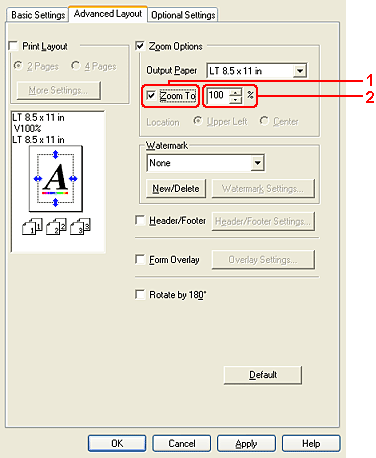
 |  |
Note: |
 |  |
|
The percentage can be set between 50% and 200% in 1% increments.
|
|
 |
Click OK to apply the settings.
|
If necessary, select the paper size to be printed from the Output Paper drop-down list.
Modifying the print layout
Your printer can print either two or four pages onto a single page and specifies the printing order, automatically resizing each page to fit the specified paper size. You can also choose to print documents surrounded by a frame.
 |
Click the Advanced Layout tab.
|
 |
Select the Print Layout check box and the number of pages you want to print on one sheet of paper. Then click More Settings. The Print Layout Settings dialog box appears.
|
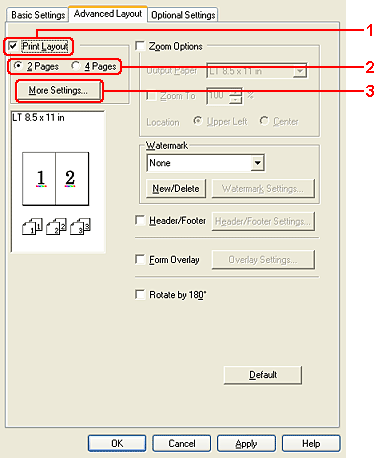
 |
Select the Page Order in which the pages are printed on each sheet.
|
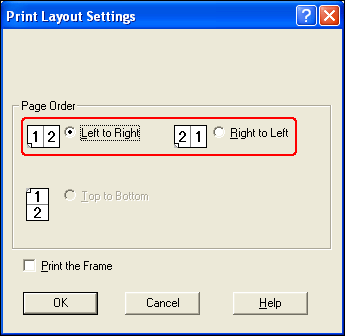
 |
Select the Print the Frame check box when you want to print the pages surrounded by a frame.
|
 |  |
Note: |
 |  |
|
The Page Order choices depend on the number of pages selected above, and the paper orientation (Portrait or Landscape) selected on the Basic Settings tab.
|
|
 |
Click OK to apply the settings and return to the Advanced Layout tab.
|
Follow the steps below to use a watermark on your document. On the Advanced Layout tab or Watermark dialog box, you can select from a list of predefined watermarks, or you can make an original watermark with text or a bitmap. The Watermark dialog box also allows you to make a variety of detailed watermark settings. For example, you can select the size, intensity, and position of your watermark.
 |
Click the Advanced Layout tab.
|
 |
Select a watermark that you want to use from the Watermark drop-down list. If you want to make detailed settings, click Watermark Settings. The Watermark dialog box appears.
|
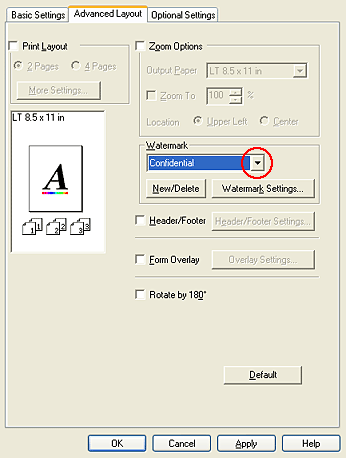
 |  |
Note: |
 |  |
|
If you select User Name or Computer Name from the Water Mark drop-down list, the login account name or computer name is printed.
|
|
 |
Select the color from the Color drop-down list, then adjust the image intensity of the watermark with the Intensity slider bar.
|
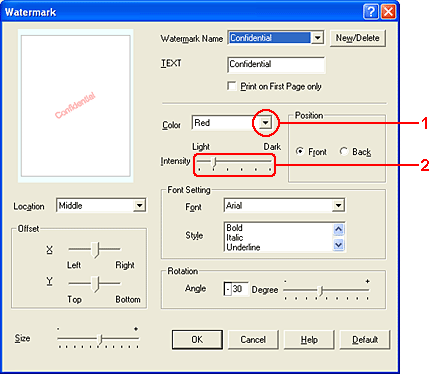
 |
Select Front (to print the watermark in the foreground of the document) or Back (to print the watermark in the background of the document) for the Position setting.
|
 |
Select the location on the page where you want to print the watermark from the Location drop-down list.
|
 |
Adjust the X (horizontal) or Y (vertical) Offset position.
|
 |
Adjust the size of the watermark with the Size slider bar.
|
 |
Click OK to apply the settings and return to the Advanced Layout tab.
|
You can make a new watermark as follows:
 |
Click the Advanced Layout tab.
|
 |
Click New/Delete. The User Defined Watermarks dialog box appears.
|
 |  |
Note: |
 |  |
|
The User Defined Watermarks dialog box also appears by clicking New/Delete in the Watermark dialog box.
|
|
 |
Select Text or BMP and type a name for the new watermark in the Name box.
|

 |  |
Note: |
 |  |
|
This screen appears when you select Text.
|
|
 |
If you select Text, type the watermark text in the Text box. If you select BMP, click Browse, select the BMP file you want to use, then click OK.
|
 |
Click Save. Your watermark will appear in the List box.
|
 |
Click OK to apply the new watermark settings.
|
 |
Note: |
 |
|
You can register up to 10 watermarks.
|
|
Using headers and footers
You can print a header or footer on the top or bottom of a page. The items that can be printed as a header or footer include user name, computer name, date, date/time, or collate number.
 |
Click the Advanced Layout tab.
|
 |
Select the Header/Footer check box, then click Header/Footer Settings.
|

 |
Select the items to be printed for the header and the footer from the drop-down list.
|
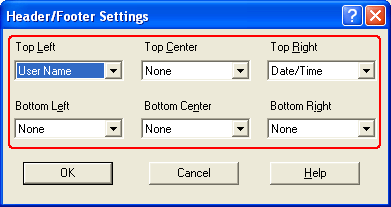
 |  |
Note: |
 |
Click OK to apply the settings and return to the Advanced Layout tab.
|
The Overlay Settings dialog box allows you to prepare standard forms, or templates, that you can use as overlays when printing other documents. This feature can be useful for creating corporate letterheads or invoices.
 |
Note: |
 |
|
The overlay function is available only when High Quality (Printer) is selected for the Printing Mode in the Extended Settings dialog box from the Optional Settings tab.
|
|
Follow the steps below to create and save a form overlay file.
 |
Open your application and create the file that you want to use as an overlay.
|
 |
When the file is ready to be saved as an overlay, choose Print or Print Setup from the File menu of your application, then click Printer, Setup, Options, Properties, or a combination of these buttons, depending on your application.
|
 |
Click the Advanced Layout tab.
|
 |
Select the Form Overlay check box, then click Overlay Settings. The Overlay Settings dialog box appears.
|
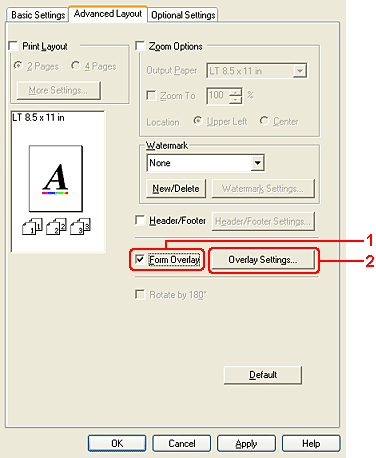
 |
Select Create Overlay Data, then click Settings. The Form Settings dialog box appears.
|
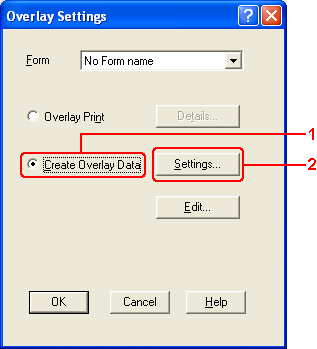
 |
Select the Use Form Name check box, then click Add Form Name. The Add Form dialog box appears.
|

 |  |
Note: |
 |  |
|
If the Assign to Paper Source check box is selected, the form name is displayed in the Paper Source drop-down list on the Basic Settings tab.
|
|
 |
Type the form name in the Form Name box and its description in the Description box.
|
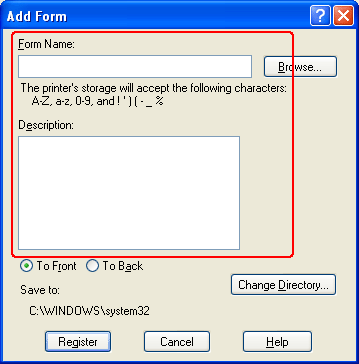
 |
Select To Front or To Back to specify whether the overlay will be printed as foreground or background of the document.
|
 |
Click Register to apply the settings and return to Form settings dialog box.
|
 |
Click OK in the Form Settings dialog box.
|
 |
Click OK in the Overlay Settings dialog box.
|
 |
Print the file saved as overlay data. It is possible to save any kind of file as an overlay. The overlay data is created.
|
Follow the steps below to print a document with overlay data.
 |
Open the file to print with overlay data.
|
 |
From the application, access the printer driver. Open the File menu, choose Print or Print Setup, then click Printer, Setup, Options, Properties, or a combination of these buttons, depending on your application.
|
 |
Click the Advanced Layout tab.
|
 |
Select the Form Overlay check box, and click Overlay Settings to open the Overlay Settings dialog box.
|
 |
Choose the form from the Form drop-down list, then click OK to return the Advanced Layout tab.
|
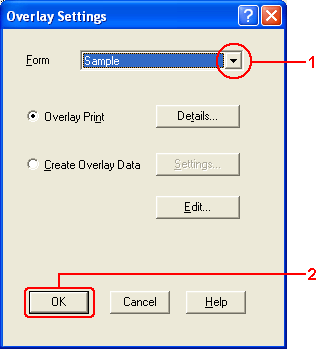
 |  |
Note: |
 |  |
|
If the Assign to Paper Source check box is selected, the form name is displayed in the Paper Source drop-down list on the Basic Settings tab. You can also select the form without accessing the dialog box above.
|
|
 |
Click OK to print the data.
|
Different printer settings overlay data
The overlay data is made with the current printer settings (such as Orientation: Portrait). If you want to make the same overlay with different printer settings (such as Landscape), follow the instructions below.
 |
Make the printer settings and exit the printer driver.
|
 |
Send the same data that you made by application to the printer like step 12 in Creating an overlay.
|
This setting is available only for Form Name data.
Using storage form overlay
This function enables faster printing with form overlay data. Windows users can use the form data registered on the USB memory installed in the printer’s USB Host interface or delete the form data on the USB memory. You can access this function from the Form Selection dialog box in the printer driver.
 |
Note: |
Register the form overlay data on the USB memory
Only a network administrator using Windows XP, XP x64, 2000, Server 2003, or Server 2003 x64 is allowed to register the form overlay data on the USB memory, using the following steps.
 |
Note: |
 |
|
The form name must use only the characters shown below. A - Z, a - z, 0 - 9, and ! ’ ) ( - _ %
|
|
 |
Prepare the form overlay data to register on the local PC Hard Disk Drive.
|
 |
Log in to Windows XP, XP x64, 2000, Server 2003, or Server 2003 x64 as an administrator.
|
 |
For Windows 2000, click Start, point to Settings, and then click Printers.
For Windows XP, XP x64, Server 2003, or Server 2003 x64 click Start, point to Control Panel, and then double-click the Printers and Faxes icon.
|
 |
Right-click the EPSON xxx xxx icon and then click Properties.
|
 |
Click the Optional Settings tab.
|
 |
Click Register. The Register to Storage dialog box appears.
|
 |
Select the form name from the Form Names list, and then click Register.
|

 |  |
Note: |
 |  |
|
Only form names that can be registered appear on the Form Name list.
|
|
 |
If you plan to distribute the form list to the clients, click Print List to print the list.
|
 |
Click Back to close the Register to Storage dialog box.
|
 |
Click OK to close the window.
|
Printing with storage form overlay
All Windows users can use the registered form data on the USB memory. Follow the steps below to print with storage form data.
 |
Click the Advanced Layout tab.
|
 |
Select the Form Overlay check box, and click Overlay Settings. The Overlay Settings dialog box appears.
|
 |
Select No Form name in the Form drop-down list, and click Details. The Form Selection dialog box appears.
|
 |  |
Note: |
 |  |
|
Make sure that No Form name is selected. If any form name is selected, another dialog box will appear.
|
|
 |
Click Printer’s Storage. Type the form name in the text box, or click Browse and select the registered form name if the printer is connected through a network.
|
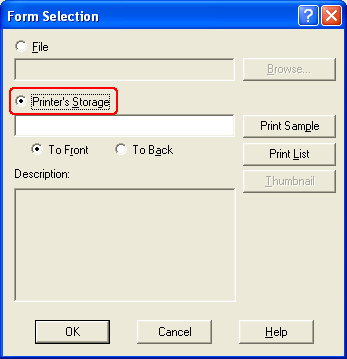
 |  |
Note: |
 |  |
-
If you need the list of the registered form data, click Print List to print it and confirm the form name.
Also, if you need a sample print-out of the form data, enter the form name, then click Print Sample.
|
|
 |
Select To Front or To Back to print the form data as foreground or background of the document, then click OK to return to the Advanced Layout tab.
|
 |
Click OK to print data.
|
Delete the form overlay data on the USB memory
Only a network administrator using Windows XP, XP x64, 2000, Server 2003, or Server 2003 x64 is allowed to delete or edit the form overlay data on the USB memory, using the following steps.
 |
Log in to Windows XP, XP x64, 2000, Server 2003, or Server 2003 x64 as an administrator.
|
 |
For Windows 2000, click Start, point to Settings, and then click Printers.
For Windows XP, XP x64, Server 2003, or Server 2003 x64 click Start, point to Control Panel, and then double-click the Printers and Faxes icon.
|
 |
Right-click the EPSON xxx xxx icon and then click Properties.
|
 |
Click the Optional Settings tab.
|
 |
Click Delete. The Delete from Storage dialog box appears.
|
 |
If you delete all form data, click the All button, then click Delete. If you want to delete some specific data, click the Selected button, enter the form name in the Form Name edit box, then click Delete.
|
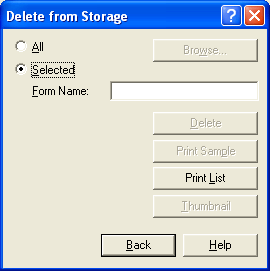
 |  |
Note: |
 |  |
-
If you need the list of the registered form data, click Print List to print it and confirm the form name. Also, if you need a sample print-out of the form data, enter the form name and click the Print Sample button.
|
|
 |
Click Back.
|
 |
Click OK to close the dialog box.
|
You can make various settings in the Extended Settings dialog box. To open the dialog box, click Extended Settings on the Optional Settings tab.
 |
Note: |
 |
|
The printer driver’s online help provides details on printer driver settings.
|
|
You can update the installed option information manually if you have installed options to your printer.
 |
Access the printer driver.
|
 |
Click the Optional Settings tab, then select Update the Printer Option Info Manually.
|
 |
Click Settings. The Optional Settings dialog box appears.
|
 |
Make settings for each installed option, then click OK.
|
To confirm the current status of the printer, print a status sheet from the printer driver. The status sheet contains information about the printer, the current settings.
Follow the steps below to print a status sheet.
 |
Access the printer driver.
|
 |
Click the Optional Settings tab and then click Status Sheet. The printer starts printing a status sheet.
|
|  |
































 Making the print quality settings
Making the print quality settings




 Top
Top




 Start/Stop button.
Start/Stop button.

